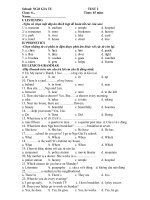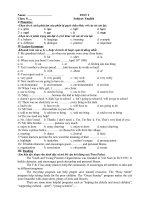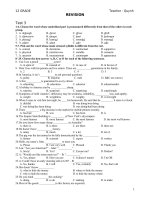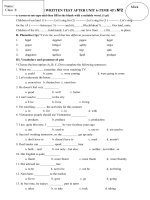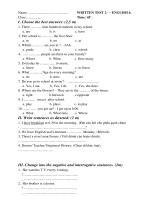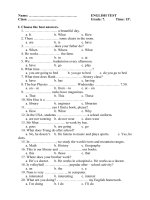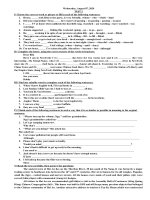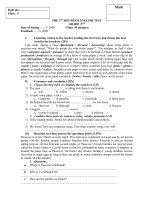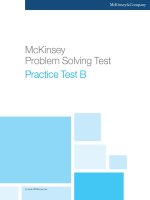manhattan test 2 answers
Bạn đang xem bản rút gọn của tài liệu. Xem và tải ngay bản đầy đủ của tài liệu tại đây (124.96 KB, 41 trang )
Answers:
1. The ratio of buses to cars can be expressed as 2x: 23x. We can
write an equation that represents the fact that there are 630 fewer
buses than cars: 2x + 630 = 23x.
Solving this equation for x yields the following:
2x + 630 = 23x
630 = 21x
30 = x.
There are 23x cars on River Road which equals 23 × 30 = 690 cars.
The correct answer is D.
2. Simplify this equation by factoring out 49 from the numerator
and the denominator as follows:
The correct answer is B.
3. Recognize here the basic form (x –y)
2
, which equals x
2
- 2xy +
y
2
.
corresponds here to x, and
So the expression can be simplified to:
49 + 49
49(1 + 49)
=
49(2)
=
49 (1+49)
2
50
1
25
=
=
Under the radical, recognize the basic form (a + b)(a – b), which
equals a
2
– b
2
.
The expression can be further simplified to:
The correct answer is C.
4. If the square root of p
2
is an integer, p is a perfect square. Let’s
take a look at 36, an example of a perfect square to extrapolate
some general rules about the properties of perfect squares.
Statement I: 36’s factors can be listed by considering pairs of
factors (1, 36) (2, 18) (3,12) (4, 9) (6, 6). We can see that they are
9 in number. In fact, for any perfect square, the number of factors
will always be odd. This stems from the fact that factors can always
be listed in pairs, as we have done above. For perfect squares,
however, one of the pairs of factors will have an identical pair, such
as the (6,6) for 36. The existence of this “identical pair” will always
make the number of factors odd for any perfect square. Any number
that is not a perfect square will automatically have an even number
of factors. Statement I must be true.
Statement II: 36 can be expressed as 2 x 2 x 3 x 3, the product of 4
prime numbers.
A perfect square will always be able to be expressed as the product
of an even number of prime factors because a perfect square is
formed by taking some integer, in this case 6, and squaring it. 6 is
comprised of one two and one three. What happens when we square
this number? (2 x 3)
2
= 2
2
x 3
2
. Notice that each prime element of 6
will show up twice in 6
2
. In this way, the prime factors of a perfect
square will always appear in pairs, so there must be an even
number of them. Statement II must be true.
Statement III: p, the square root of the perfect square p
2
will have
an odd number of factors if p itself is a perfect square as well and
an even number of factors if p is not a perfect square. Statement III
is not necessarily true.
The correct answer is D, both statements I and II must be true.
5. (1) INSUFFICIENT: This gives the definition of the $ function,
however, it gives us no information about p and q.
(2) INSUFFICIENT: This statement gives us no information about
the $ function.
(1) AND (2) SUFFICIENT: We can use the definition of the $ function
given in (1) along with the values of p and q from (2) to solve for
the value of p $ q = 2(4)2 - 10 = 6.
The correct answer is C.
6. At the point where a curve intercepts the x-axis (i.e. the x
intercept), the y value is equal to 0. If we plug y = 0 in the
equation of the curve, we get 0 = (x – p)(x – q). This product would
only be zero when x is equal to p or q. The question is asking us if
(2, 0) is an x-intercept, so it is really asking us if either p or q is
equal to 2.
(1) INSUFFICIENT: We can’t find the value of p or q from this
equation.
(2) INSUFFICIENT: We can’t find the value of p or q from this
equation.
(1) AND (2) SUFFICIENT: Together we have enough information to
see if either p or q is equal to 2. To solve the two simultaneous
equations, we can plug the p-value from the first equation, p = -
8/q, into the second equation, to come up with -2 + 8/q = q.
This simplifies to q
2
+ 2q – 8 = 0, which can be factored (q + 4)(q –
2) = 0, so q = 2, -4.
If q = 2, p = -4 and if q = -4, p =2. Either way either p or q is equal
to 2.
The correct answer is C.
7. In order to determine the median of a set of integers, we need to
find the "middle" value.
(1) SUFFICIENT: Statment one tells us that average of the set of
integers from 1 to x inclusive is 11. Since this is a set of consecutive
integers, the "average" term is always the exact middle of the set.
Thus, in order to have an average of 11, the set must be the
integers from 1 to 21 inclusive. The middle or median term is also is
11.
(2) SUFFICIENT: Statement two states that the range of the set of
integers from 1 to x inclusive is 20. In order for the range of
integers to be 20, the set must be the integers from 1 to 21
inclusive. The median term in this set is 11.
The correct answer is D.
8.
The distance from G to H is 5
13
- 5
12
.
The distance between and two consecutive points is constant, so the
distance from A to G will be 6 times the distance from G to H or
6(5
13
– 5
12
).
The value of A, therefore, will be equal to the value of G minus the
distance from A to G:
5
12
– 6(5
13
– 5
12
) 5
12
– 6[5
12
(5 – 1)] 5
12
–
6(5
12
)(4) 5
12
(1 – 24) (-23)5
12
.
The correct answer is B.
9. If we multiply both sides of the equation by (x + 2), we get 1.5x
+ 3 = 1.8.
If we multiply both sides of the equation by 2, we get 3x + 6 = 3.6
Further simplifying, 3x = -2.4, so x = -0.8.
The correct answer is B.
10. From the diagram, we see that all 6 of the labeled angles add up
to 360°:
3a + 3b = 360
a + b = 120 (a = 120 – b or b = 120 – a)
(1) SUFFICIENT: We can use the value of a to solve for b (b = 120
- 35 = 85). We can then see that b > a.
(2) SUFFICIENT: If a < 60 and b = 120 - a, then b = 120 - less
than 60.
Therefore, b must be greater than 60 and consequently greater than
a.
The correct answer is D.
11. We can determine the sales revenue that the sales associate
generated by analyzing her commission earnings for the week.
(1) SUFFICIENT: The sales associate earned a total of $1500 in
commission last week. We know that on the first $10,000 in sale
revenue, the associate earns 8% or $800 in commission. This
means that the associate earned $700 in additional commission.
Since this additional commission is calculated based on a 10%
rate, the sales associate must have generated an additional $7000
worth of sales revenue. Thus, we know from statement 1 that the
sales associate generated $10,000 + $7000 = $17,000 in sales
revenue last week. Statement 1 alone is sufficient.
(2) SUFFICIENT: The sales associate was eligible for the 10%
commission rate on $7000 worth of sales. Since the 10% rate only
kicks in after the first $10,000 in sales, this means that the sales
associate generated $7000 in sales revenue above the $10,000
threshold. Thus, we know from statement 2 that the sales associate
generated $10,000 + $7000 = $17,000 in sales revenue last week.
Statement 2 alone is sufficient.
The correct answer is D.
12.
(15
x
+ 15
x+1
)
=15
y
4
y
[15
x
+ 15
x
(15
1
)]
=15
y
4
y
(15
x
)(1 + 15)=15
y
4
y
(15
x
)(16)
=15
y
4
y
(3
x
)(5
x
)(2
4
) = (3
y
)(5
y
)(2
2y
)
Since both sides of the equation are broken down to the product of
prime bases, the respective exponents of like bases must be equal.
2y = 4 so y = 2.
x = y so x = 2.
The correct answer is A.
13. We can solve this question as a VIC (Variable in answer choices)
by plugging in values for x, y and z:
x
percent mark-up (1st) 10
y
percent discount (2nd) 20
z
original price 100
If a $100 item is marked up 10% the price becomes $110. If that
same item is then reduced by 20% the new price is $88.
15
x
+ 15
x
+1
4
y
=
15
y
If we plug x = 10, y = 20, z = 100 into the answer choices, only
answer choice (A) gives us 88:
If we plug x = 10, y = 20, z = 100 into the answer choices, only
answer choice (A) gives us 88:
The correct answer is A.
14. For an overlapping set problem we can use a double-set matrix
to organize our information and solve. Because the values here are
percents, we can assign a value of 100 to the total number of lights
at Hotel California. The information given to us in the question is
shown in the matrix in boldface. An x was assigned to the lights
that were “Supposed To Be Off” since the values given in the
problem reference that amount. The other values were filled in
using the fact that in a double-set matrix the sum of the first two
rows equals the third and the sum of the first two columns equals
the third.
Supposed
To Be On
Supposed
To Be Off
TOTAL
Actually
on
0.4x 80
Actually
off
0.1(100
– x)
0.6x 20
TOTAL 100 – x x 100
Using the relationships inherent in the matrix, we see that:
0.1(100 – x) + 0.6x = 20
10 – 0.1x + 0.6x = 20
0.5x = 10 so x = 20
We can now fill in the matrix with values:
Supposed
To Be On
Supposed
To Be Off
TOTAL
10,000(100) + 100(100)(10 –20) – (10)(20)(100)
10,000
= 88
Actually
on
72 8 80
Actually
off
8 12 20
TOTAL 80 20 100
Of the 80 lights that are actually on, 8, or 10% percent, are
supposed to be off.
The correct answer is D.
15. To determine the value of 10 – x, we must determine the exact
value of x. To determine the value of x, we must find out what digits
a and b represent. Thus, the question can be rephrased: What is a
and what is b?
(1) INSUFFICIENT: This tells us that x rounded to the nearest
hundredth must be 1.44. This means that a, the hundredths
digit, might be either 3 (if the hundredths digit was rounded up to
4) or 4 (if the hundredths digit was rounded down to 4). This
statement alone is NOT sufficient since it does not give us a
definitive value for a and tells us nothing about b.
(2) SUFFICIENT: This tells us that x rounded to the nearest
thousandth must be 1.436. This means, that a, the hundredths
digit, is equal to 3. As for b, the thousandths digit, we know that it
is followed by a 5 (the ten-thousandths digit); therefore, if x is
rounded to the nearest thousandth, b must rounded UP. Since b is
rounded UP to 6, then we know that b must be equal to 5.
Statement (2) alone is sufficient because it provides us with
definitive values for both a and b.
The correct answer is B.
16. It is tempting to view the information in the question as
establishing a pattern as follows:
Green, Yellow, Red, Green, Yellow, Red, . . .
However, consider that the following non-pattern is also possible:
Green, Yellow, Red, Green, Green, Green, Green . . .
(1) INSUFFICIENT: This tells us that the 18th tile is Green or Red
but this tells us nothing about the 24th tile. Statement (1) alone is
NOT sufficient.
(2) INSUFFICIENT: This tells us that the 19th tile is Yellow or Red
but this tells us nothing about the 24th tile. Statement (2) alone is
NOT sufficient.
(1) AND (2) INSUFFICIENT: Together, the statements yield the
following possibilities for the 18th and 19th tiles:
GY, GR, RY, or RR
However, only GY adheres to the rules given in the question. Thus,
we know that tile 18 is green and tile 19 is yellow. However, this
does not help us to determine the color of the next tile, much less
tile 24 (the one asked in the question). For example, the next tile
(tile 20) could be green or red. Thus, the statements taken together
are still not sufficient.
The correct answer is E.
17. (1) INSUFFICIENT: If we simplify the inequality by adding 3 to
both sides and dividing by 2, we get x < 4. There are an infinite
number of x values less than 4.
(2) INSUFFICIENT: If we simplify the inequality by dividing both
sides by -4 and switching the direction of the inequality, we get x >
2. There are an infinite number of x values greater than 2.
(1) AND (2) SUFFICIENT: If x is an integer and 2 < x < 4, x must
equal 3.
The correct answer is C.
18. 84 is the 12th multiple of 7. (12 x 7 = 84)
140 is the 20th multiple of 7.
The question is asking us to sum the 12th through the 20th
multiples of 7.
The sum of a set = (the mean of the set) x (the number of terms in
the set)
There are 9 terms in the set: 20th - 12th + 1 = 8 + 1 = 9
The mean of the set = (the first term + the last term) divided by 2:
(84 + 140)/2 = 112
The sum of this set = 112 x 9 = 1008
Alternatively, one could list all nine terms in this set (84, 91, 98
140) and add them.
When adding a number of terms, try to combine terms in a way that
makes the addition easier
(i.e. 98 + 112 = 210, 119 + 91 = 210, etc).
The correct answer is C.
19. Begin by counting the number of relationships that exist among
the 7 individuals whom we will call A, B, C, D, E, F, and G.
First consider the relationships of individual A: AB, AC, AD, AE, AF,
AG = 6 total. Then consider the relationships of individual B without
counting the relationship AB that was already counted before: BC,
BD, BE, BF, BG = 5 total. Continuing this pattern, we can see that C
will add an additional 4 relationships, D will add an additional 3
relationships, E will add an additional 2 relationships, and F will add
1 additional relationship. Thus, there are a total of 6 + 5 + 4 + 3 +
2 + 1 = 21 total relationships between the 7 individuals.
We are told that 4 people have exactly 1 friend. This would account
for 2 "friendship" relationships (e.g. AB and CD). We are also told
that 3 people have exactly 2 friends. This would account for
another 3 "friendship" relationships (e.g. EF, EG, and FG). Thus,
there are 5 total "friendship" relationships in the group.
The probability that any 2 individuals in the group are friends is
5/21. The probability that any 2 individuals in the group are not
friends = 1 – 5/21 = 16/21. The correct answer is E.
20. Since BE CD, triangle ABE is similar to triangle ACD (parallel
lines imply two sets of equal angles). We can use this relationship
to set up a ratio of the respective sides of the two triangles:
So AD = 8.
We can find the area of the trapezoid by finding the area of triangle
CAD and subtracting the area of triangle ABE.
Triangle CAD is a right triangle since it has side lengths of 6, 8 and
10, which means that triangle BAE is also a right triangle (they
share the same right angle).
Area of trapezoid = area of triangle CAD – area of triangle BAE
= (1/2)bh – (1/2)bh
= 0.5(6)(8) – 0.5(3)(4)
= 24 – 6
= 18
The correct answer is B.
21. (1) INSUFFICIENT: If we subtract 3x from both sides and
factor out an x, we get:
x(x + 3)(x – 1) = 0, so x = -3, 0, or 1.
(2) INSUFFICIENT: This can be factored as (x – 5)(x + 3) = 0, so
x = -3 or 5.
(1) AND (2) SUFFICIENT: With the two statements together we
know x must equal -3.
The correct answer is C.
AB
AC
AE
AD
=
3
6
4
AD
=
22. m/n will be an integer if m is divisible by n. For m to be
divisible by n, the elements of n's prime box (i.e. the prime factors
that make up n) must also appear in m's prime box.
(1) INSUFFICIENT: If 2m is divisible by n, the elements of n's prime
box are in 2m's prime box. However, since 2m contains a 2 in its
prime box because of the coefficient 2, m alone may not have all of
the elements of n's prime box. For example, if 2m = 6 and n = 2,
2m is divisible by n but m is not.
(2) SUFFICIENT: If m is divisible by 2n, m's prime box contains a 2
and the elements of n's prime box. Therefore m must be divisible
by n.
The correct answer is B.
23. Begin by assigning variables to the unknown quantities:
L = left-handed writers
R = right-handed writers
Then, write equations using the information given in the problem.
L + R = 80 and L = R + 12
Substitute the second equation into the first equation to solve for R
as follows:
L + R = 80
(R + 12) + R = 80
2R = 68
R = 34
The question asks for the number of writers who are NOT left-
handed which is the same as asking for the number of right-handed
writers (34). The correct answer is C.
numerator ab
2
is even.
If ab
2
were odd, the quotient would never be divisible by 2,
regardless of what c is. To prove this try to divide an odd number
by any integer to come up with an even number; you can't. If ab
2
is even, either a is even or b is even.
(I) TRUE: Since a or b is even, the product ab must be even
(II) NOT NECESSARILY: For the quotient to be positive, a and c
must have the same sign since b
2
is definitely positive. We know
nothing about the sign of b. The product of ab could be negative or
positive.
(III) NOT NECESSARILY: For the quotient to be even, ab
2
must be
even but c could be even or odd. An even number divided by an
odd number could be even (ex: 18/3), as could an even number
divided by an even number (ex: 16/4).
The correct answer is A.
25. The solution to a problem such as this often looks less appealing
than some of the incorrect answers. Thus, it is important to
methodically analyze each answer choice.
B: Any fraction between 0 and 1 multiplied by itself will decrease in
value. Thus (2/3) multiplied by itself will yield a result that is less
than 2/3.
C. (0.7) × (0.7) = 0.49. This is approximately 1/2, which is less
than 2/3.
ab
2
c
24. The fact that the quotient
is even tells us that the
5
7
×
5
7
=
25
49
. This is approximately 1/2, which is less than 2/3
A:
D. (0.9)
2
× (0.9)
2
= (0.81) ×(0.81). This is approximately 0.65,
which is less than 2/3.
Then, 27 × 27 is clearly greater than 2/3.
The correct answer is E.
26. The circumference of the circle is .
We can use this information to find the area of the circular base.
Because the probability of the stone landing outside the triangle
is 3/4 , the triangle must comprise 1/4 of the area of the circular
base.
The height of an equilateral triangle splits the triangle into two 30-
60-90 triangles (Each 30-60-90 triangle has sides in the ratio of 1:
: 2). Because of this, the area for an equilateral triangle can be
expressed in terms of one side. If we call the side of the equilateral
triangle, s, the height must be (s ) / 2 (using the 30-60-90
relationships).
The area of a triangle = 1/2 × base × height, so the area of an
equilateral triangle can be expressed as: 1/2 × s × (s ) / 2 .
0.08
0.003
=
80
3
. This is approximately 27.
E:
Here the triangle has an area of , so:
= 1/2 × s × (s ) / 2
s = 2
The correct answer is E.
27. We can rephrase the question by opening up the absolute value
sign. There are two scenarios for the inequality |n| < 4.
If n > 0, the question becomes “Is n < 4?”
If n < 0, the question becomes: “Is n > -4?”
We can also combine the questions: “Is -4 < n < 4?” ( n is not
equal to 0)
(1) SUFFICIENT: The solution to this inequality is n > 4 (if n > 0) or
n < -4 (if n < 0). This provides us with enough information to
guarantee that n is definitely NOT between -4 and 4. Remember
that an absolute no is sufficient!
(2) INSUFFICIENT: We can multiply both sides of the inequality by
|n| since it is definitely positive. To solve the inequality |n| × n < 1,
let’s plug values. If we start with negative values, we see that n can
be any negative value since |n| × n will always be negative and
therefore less than 1. This is already enough to show that the
statement is insufficient because n may not be between -4 and 4.
The correct answer is A.
28. The question asks about the sign of d.
(1) INSUFFICIENT: When two numbers sum to a negative value, we
have two possibilities:
Possibility A: Both values are negative (e.g., e = -4 and d = -8)
Possibility B: One value is negative and the other is positive.(e.g., e
= -15 and d = 3).
(2) INSUFFICIENT: When the difference of two numbers produces
a negative value, we have three possibilities:
Possibility A: Both values are negative (e.g., e = -20 and d = -3)
Possibility B: One value is negative and the other is positive (e.g., e
= -20 and d = 3).
Possibility C: Both values are positive (e.g., e = 20 and d = 30)
(1) AND (2) SUFFICIENT: When d is ADDED to e, the result (-12) is
greater than when d is SUBTRACTED from e. This is only possible if
d is a positive value. If d were a negative value than adding d to a
number would produce a smaller value than subtracting d from that
number (since a double negative produces a positive). You can test
numbers to see that d must be positive and so we can definitively
answer the question using both statements.
29. (1) INSUFFICIENT: If we test values here we find two sets of
possible x and y values that yield conflicting answers to the
question.
x
y Is x > y?
4 2 1 YES
1/4 1/2 1/3 NO
(2) INSUFFICIENT: If we test values here we find two sets of
possible x and y values that yield conflicting answers to the
question.
x x
3
y Is x > y?
2 8 1 YES
-1/2 -1/8 -1/4 NO
(1) AND (2) SUFFICIENT: Let’s start with statement 1 and add the
constraints of statement 2. From statement 1, we see that x has to
be positive since we are taking the square root of x. There is no
point in testing negative values for y since a positive value for x
against a negative y will always yield a yes to the question. Lastly,
we should consider x values between 0 and 1 and greater than 1
because proper fractions behave different than integers with regard
to exponents. When we try to come up with x and y values that fit
both conditions, we must adjust the two variables so that x is
always greater than y.
x
x
3
y Is x > y?
2 1.4
8 1 YES
1/4
1/2
1/64
1/128
YES
Logically it also makes sense that if the cube and the square root of
a number are both greater than another number than the number
itself must be greater than that other number.
The correct answer is C.
30. First we must find the total number of 5 member teams, with
our without John and Peter. We can solve this using an anagram
model in which each of the 9 players (A – I) is assigned either a Y
(for being chosen) or an N (for not being chosen):
Player
A B C D E F G H I
Chosen ?
Y Y Y Y Y N N N N
It is the various arrangements of Y’s and N’s above that would yield
all of the different combinations, so we can find the number of
possible teams here by considering how many anagrams of
YYYYYNNNN exist:
(because there are 9! ways to order 9 objects)
(because the 5Y's and 4N's are identical)
So there are 126 possible teams of 5. Since the question asks for
the probability of choosing a team that includes John and Peter, we
need to determine how many of the 126 include John and Peter. If
we reserve two of the 5 spots on a team for John and Peter, there
will be 3 spots left, which must be filled by 3 of the remaining 7
players (remember John and Peter were already selected).
Therefore the number of teams including John and Peter will be
equal to the number of 3-player teams that can be formed from a 7-
player pool. We can approach the problem as we did above:
9!
5! 4!
=
9 × 8 × 7 × 6 × 5
5 × 4 × 3 × 2 × 1
=
(3 × 7 × 6) = 126
Player
A B C D E F G
Chosen
Y Y Y N N N N
The number of possible YYYNNNN anagrams is:
Since 35 of the total possible 126 teams include John and Peter, the
probability of selecting a team with both John and Peter is 35/126 or
5/18.
The correct answer is D.
31. We can factor the equation in the question :
Alternatively we could solve this question as a VIC (Variable in
answer choice) by plugging a value for x.
If x = 2, the original equation becomes y
2
– 16 = y – 4 or (y +
4)(y – 4) = y – 4
Since we are told that y does not equal 0, we can divide both sides
by (y – 4) to get y + 4 = 1.
This means that y = -3 when x = 2.
Unfortunately two answer choices yield a y value of -3 when x = 2
(both B and C). In this case we would have to repeat the process
7!
3! 4!
=
7 × 6 × 5
3 × 2 ×1
=
35
(y + 4)(y – 4)
3x
=
y – 4
6
(y + 4)(y – 4)
3x
=
y – 4
6
Since , we can then simplify:
y + 4
=
x
2
, so y =
x – 8
2
Finally,
for a different x value. x = 4, y = -2 only works for answer choice
B. The correct answer is B.
32. We can solve this problem as a VIC (Variable In answer Choice)
and plug in values for the variable x. Let’s say x = 6. (Note that
there is a logical restriction here in terms of the value of x. Lindsay
has to have a rate of less than less than 1 room per hour if she
needs Joseph’s help to finish in an hour).
If Lindsay can paint 1/6 of the room in 20 minutes (1/3 of an hour),
her rate is 1/2.
rt = w
r(1/3) = 1/6
r = 1/2
Let J be the number of hours it takes Joseph to paint the entire
room. Joseph’s rate then is 1/J. Joseph and Lindsay’s combined
rate is 3/2 + 1/J, which can be simplified:
1/2 + 1/J J / 2J + 2 / 2J (J + 2) / 2J
If the two of them finish the room in one hour, using the formula of
rt = w, we can solve for J.
rt = w and t = 1 (hour), w = 1 (job)
((J + 2) / 2J )(1) = 1 J + 2 = 2J J = 2
That means that Joseph’s rate is 1/2, the same as Lindsay’s. The
question though asks us what fraction of the room Joseph would
complete in 20 minutes, or 1/3 of an hour.
rt = w
(1/2)(1/3) = w
w = 1/6
Now we must look at the answer choices to see which one is equal
to 1/6 when we plug in x = 6. Only C works: (6 – 3) / 18 = 1/6.
The correct answer is C.
33. We can rewrite the information in the question as an equation
representing the T, the total dollar value of the sale:
L + M + S = T
L = the dollar amount received by the partner with the largest share
M = the dollar amount received by the partner with the middle
(second largest) share
S = the dollar amount received by the partner with the smallest
share
We are also told in the question that L = (5/8)T. Thus we can
rewrite the equation as follows:
(5/8)T + M + S = T.
Since the question asks us the value of S, we can simplify the
equation again as follows:
S = M + (3/8)T
Thus, in order to solve for S, we will need to determine the value of
both M and T. The question can be rephrased as, what is the value
of M + (3/8)T?
(1) NOT SUFFICIENT: The first statement tells us that S = (1/5)M.
This gives us no information about T so statement one alone is not
sufficient.
(2) SUFFICIENT: The second statement tells us that M = (1/2)L =
$1 million. Additionally, since we know from the question that L =
(5/8)T, then M must be equal to 1/2 of 5/8(T) or 5/16(T). We can
therefore solve for T as follows:
$3,200,000 = T
We can now easily solve for S:
L + M + S = T
2 million + 1 million + S = $3.2 million
5
16
T
M = $1,000,000 =
S = .2 million
Therefore, statement (2) alone is sufficient. The correct answer is B.
34. (1) SUFFICIENT: We can rewrite this equation in a base of 3:
3
b + 2
= 3
5
, which means that b + 2 = 5 and therefore b = 3.
We can plug this value into the equation a = 3
b – 1
to solve for a.
(2) SUFFICIENT: We can set the right side of this equation equal to
the right side of the equation in the quesiton (both sides equal a).
3
b – 1
= 3
2b – 4
, which means that b – 1 = 2b – 4 and therefore b =
3. We can plug this value into the equation a = 3
b – 1
to solve for
a.
The correct answer is D.
35. Let x be the length of an edge of the cube. We
can find the length of BC by first finding the length
of CD. CD must be x since it is the hypotenuse
of a 45-45-90 triangle with legs of length x.
Using the Pythagorean theorem, BC can be calculated:
AB = CD = x , so BC – AB = x – x .
If we factor this expression and simplify, x( – ) ˜ x(1.7 –
1.4) ˜ 0.3x.
Since BC – AB ˜ 0.3x and AC = x, the difference between BC and
AB is equal to approximately 30% of AC.
The correct answer is C.
36. There are 3 × 2 × 4 = 24 possible different shirt-sweater-hat
combinations that Kramer can wear. He wears the first one on a
Wednesday. The following Wednesday he will wear the 8th
combination. The next Wednesday after that he will wear the 15th
combination. The next Wednesday after that he will wear the 22nd
combination. On Thursday, he will wear the 23rd combination and
on Friday he will wear the 24th combination.
Thus, the first day on which it will no longer be possible to wear a
new combination is Saturday. The correct answer is E.
37. One way to avoid a lot of computation on the GMAT is to look
for patterns. In this case, notice that you can factor out .1111 from
each of the four terms as follows:
.1111(9 + 8 + 7 + 6) = .1111(30) = 3.333
The correct answer is C.
1. The correct answer is E.
The original sentence begins with the modifier "hoping to alleviate
some of the financial burdens ", which clearly describes the county
government. However, the county government is not the subject of
the main clause. We need to find a choice that makes it the
subject. Moreover, the sentence is unnecessarily passive. We should
look for an active version. Finally, "raised by an eleven percent
increase" is redundant. We can say "raised by eleven percent" or
"increased by eleven percent" but we do not need both.
The only choice to address all the issues is E.
2. The correct answer is D.
The subject of the original sentence is "the mountain cornfloss,"
which is singular. However, the main verb is "grow," which is
plural. We need to replace "grow" with "grows". Moreover, "thought
of as being" is wordy and awkward. We need to find a more elegant
way to phrase this.
Choice D corrects the subject-verb issue and also finds a more
economical phrasing in "and thought to be".
3. The correct answer is B.
The dentists argue that adding fluoride to tap water lulls people into
a false sense of dental security because they rely too heavily on the
fluoride to do work they should do for themselves. This argument,
however, assumes that most people are aware that the fluoride is
added to the water. If this were not the case, the argument would
be seriously weakened because the dentists could not claim that
people rely in the fluoride. Only choice B addresses this.
4. The correct answer is D.
The passage states that health savings accounts will undermine the
health of the public because people will not use them for preventive
care. Furthermore, people who cannot afford them will not be able
to receive even basic care such as vaccinations. We are asked to
draw a conclusion based on this information.
Choice A states that wealthy individuals will not be affected
negatively by the accounts. We do not have enough information to
draw this conclusion. Incorrect.
Choice B states that private health insurance will no longer be
available. The passage does not offer information that would justify
this choice. Incorrect.
Choice C states that most diseases are detected during regular
preventive examinations. We do not have enough information to
justify this choice. Incorrect.
Choice D states that some people without the accounts are likely to
contract infectious diseases. This conclusion can be drawn from the
fact that people without the accounts will not receive vaccinations
against infectious diseases and this will result in a threat to the
public's health. Correct.
Choice E states that the causal relationship between a person's
health and medical care has been adequately documented. The
passage does not offer any information on this subject. Incorrect.
5. The correct answer is C.
The conclusion is that the use of licenses as identification is un-
American. The basis for that claim is that this use would allow the
government to restrict the liberty of its people. We are asked to find
an assumption underlying this argument.
Choice A does not connect the concept of "un-Americanness" to
restrictions on liberties. Therefore it cannot complete the logic of the
argument. Incorrect.
Choice B does not connect the concept of "un-Americanness" to
restrictions on liberties. Therefore it cannot complete the logic of the
argument. Incorrect.
Choice C does connect the concept of "un-Americanness" to
restrictions on liberties. If this choice is read into the sentence as an
additional piece of evidence, it completes the logic of the argument.
Correct.
Choice D does not connect the concept of "un-Americanness" to
restrictions on liberties. Therefore it cannot complete the logic of the
argument. Even if Americans were willing to give up their right to
move about without identification, the argument would still hold.
That is, the imposition of this new restriction could still be
considered not in keeping with traditional American values and law.
Choice E does not connect the concept of "un-Americanness" to
restrictions on liberties. Therefore it cannot complete the logic of the
argument. Incorrect.
6. Hua T'o is mentioned in the following context:
"In his talks, Parker described the state of medical and surgical
knowledge or, rather, scientific ignorance in China. Despite the
surgical feats of legendary ancient doctors like Hua T'o of the third
century A.D., surgery did not develop to any great extent in China."
The author mentions Hua T'o as a legendary 3rd century doctor in a
sentence that highlights how surgery did not develop significantly in
China. The fact that Chinese surgical knowledge was still similar to
that of an "ancient" doctor is highlighted to underscore the need to
modernize 19th century Chinese medicine.
The correct answer is A.
7. The correct answer is C. While, Parker did not feel that that 19th
century Chinese medical practices were advanced, the passage
never mentions an emotion similar to "disdain" in describing
Parker's feelings to wards these practices.
Answer choice A can be eliminated because the passage states
that Parker "acquired a reputation as a surgeon of such skill that the
hospital quickly became a general hospital."
